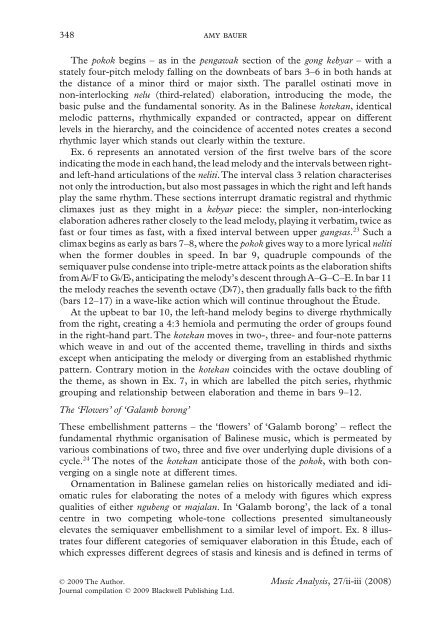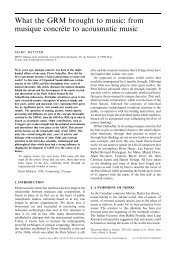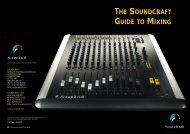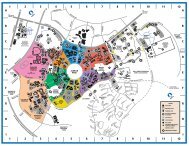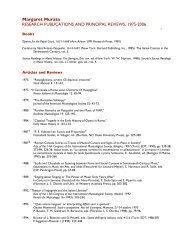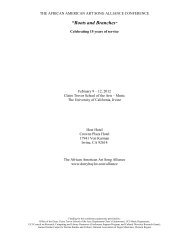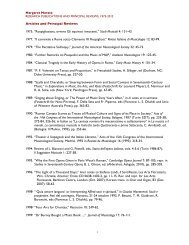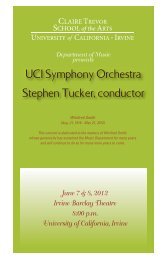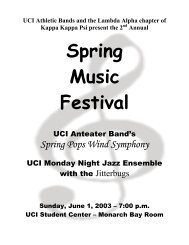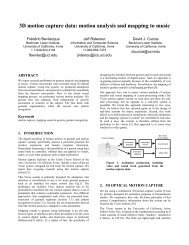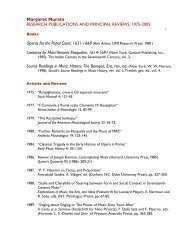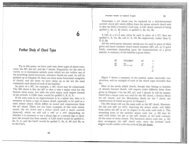amy bauer The Other of the Exotic: Balinese Music as Grammatical ...
amy bauer The Other of the Exotic: Balinese Music as Grammatical ...
amy bauer The Other of the Exotic: Balinese Music as Grammatical ...
You also want an ePaper? Increase the reach of your titles
YUMPU automatically turns print PDFs into web optimized ePapers that Google loves.
348 <strong>amy</strong> <strong>bauer</strong><br />
<strong>The</strong> pokok begins – <strong>as</strong> in <strong>the</strong> pengawak section <strong>of</strong> <strong>the</strong> gong kebyar – with a<br />
stately four-pitch melody falling on <strong>the</strong> downbeats <strong>of</strong> bars 3–6 in both hands at<br />
<strong>the</strong> distance <strong>of</strong> a minor third or major sixth. <strong>The</strong> parallel ostinati move in<br />
non-interlocking nelu (third-related) elaboration, introducing <strong>the</strong> mode, <strong>the</strong><br />
b<strong>as</strong>ic pulse and <strong>the</strong> fundamental sonority. As in <strong>the</strong> <strong>Balinese</strong> kotekan, identical<br />
melodic patterns, rhythmically expanded or contracted, appear on different<br />
levels in <strong>the</strong> hierarchy, and <strong>the</strong> coincidence <strong>of</strong> accented notes creates a second<br />
rhythmic layer which stands out clearly within <strong>the</strong> texture.<br />
Ex. 6 represents an annotated version <strong>of</strong> <strong>the</strong> first twelve bars <strong>of</strong> <strong>the</strong> score<br />
indicating <strong>the</strong> mode in each hand, <strong>the</strong> lead melody and <strong>the</strong> intervals between rightand<br />
left-hand articulations <strong>of</strong> <strong>the</strong> neliti.<strong>The</strong> interval cl<strong>as</strong>s 3 relation characterises<br />
not only <strong>the</strong> introduction, but also most p<strong>as</strong>sages in which <strong>the</strong> right and left hands<br />
play <strong>the</strong> same rhythm. <strong>The</strong>se sections interrupt dramatic registral and rhythmic<br />
climaxes just <strong>as</strong> <strong>the</strong>y might in a kebyar piece: <strong>the</strong> simpler, non-interlocking<br />
elaboration adheres ra<strong>the</strong>r closely to <strong>the</strong> lead melody, playing it verbatim, twice <strong>as</strong><br />
f<strong>as</strong>t or four times <strong>as</strong> f<strong>as</strong>t, with a fixed interval between upper gangs<strong>as</strong>. 23 Such a<br />
climax begins <strong>as</strong> early <strong>as</strong> bars 7–8, where <strong>the</strong> pokok gives way to a more lyrical neliti<br />
when <strong>the</strong> former doubles in speed. In bar 9, quadruple compounds <strong>of</strong> <strong>the</strong><br />
semiquaver pulse condense into triple-metre attack points <strong>as</strong> <strong>the</strong> elaboration shifts<br />
from A♭/F to G♭/E♭, anticipating <strong>the</strong> melody’s descent through A–G–C–E. In bar 11<br />
<strong>the</strong> melody reaches <strong>the</strong> seventh octave (D♭7), <strong>the</strong>n gradually falls back to <strong>the</strong> fifth<br />
(bars 12–17) in a wave-like action which will continue throughout <strong>the</strong> Étude.<br />
At <strong>the</strong> upbeat to bar 10, <strong>the</strong> left-hand melody begins to diverge rhythmically<br />
from <strong>the</strong> right, creating a 4:3 hemiola and permuting <strong>the</strong> order <strong>of</strong> groups found<br />
in <strong>the</strong> right-hand part.<strong>The</strong> kotekan moves in two-, three- and four-note patterns<br />
which weave in and out <strong>of</strong> <strong>the</strong> accented <strong>the</strong>me, travelling in thirds and sixths<br />
except when anticipating <strong>the</strong> melody or diverging from an established rhythmic<br />
pattern. Contrary motion in <strong>the</strong> kotekan coincides with <strong>the</strong> octave doubling <strong>of</strong><br />
<strong>the</strong> <strong>the</strong>me, <strong>as</strong> shown in Ex. 7, in which are labelled <strong>the</strong> pitch series, rhythmic<br />
grouping and relationship between elaboration and <strong>the</strong>me in bars 9–12.<br />
<strong>The</strong> ‘Flowers’ <strong>of</strong> ‘Galamb borong’<br />
<strong>The</strong>se embellishment patterns – <strong>the</strong> ‘flowers’ <strong>of</strong> ‘Galamb borong’ – reflect <strong>the</strong><br />
fundamental rhythmic organisation <strong>of</strong> <strong>Balinese</strong> music, which is permeated by<br />
various combinations <strong>of</strong> two, three and five over underlying duple divisions <strong>of</strong> a<br />
cycle. 24 <strong>The</strong> notes <strong>of</strong> <strong>the</strong> kotekan anticipate those <strong>of</strong> <strong>the</strong> pokok, with both converging<br />
on a single note at different times.<br />
Ornamentation in <strong>Balinese</strong> gamelan relies on historically mediated and idiomatic<br />
rules for elaborating <strong>the</strong> notes <strong>of</strong> a melody with figures which express<br />
qualities <strong>of</strong> ei<strong>the</strong>r ngubeng or majalan. In ‘Galamb borong’, <strong>the</strong> lack <strong>of</strong> a tonal<br />
centre in two competing whole-tone collections presented simultaneously<br />
elevates <strong>the</strong> semiquaver embellishment to a similar level <strong>of</strong> import. Ex. 8 illustrates<br />
four different categories <strong>of</strong> semiquaver elaboration in this Étude, each <strong>of</strong><br />
which expresses different degrees <strong>of</strong> st<strong>as</strong>is and kinesis and is defined in terms <strong>of</strong><br />
© 2009 <strong>The</strong> Author.<br />
Journal compilation © 2009 Blackwell Publishing Ltd.<br />
<strong>Music</strong> Analysis, 27/ii-iii (2008)


